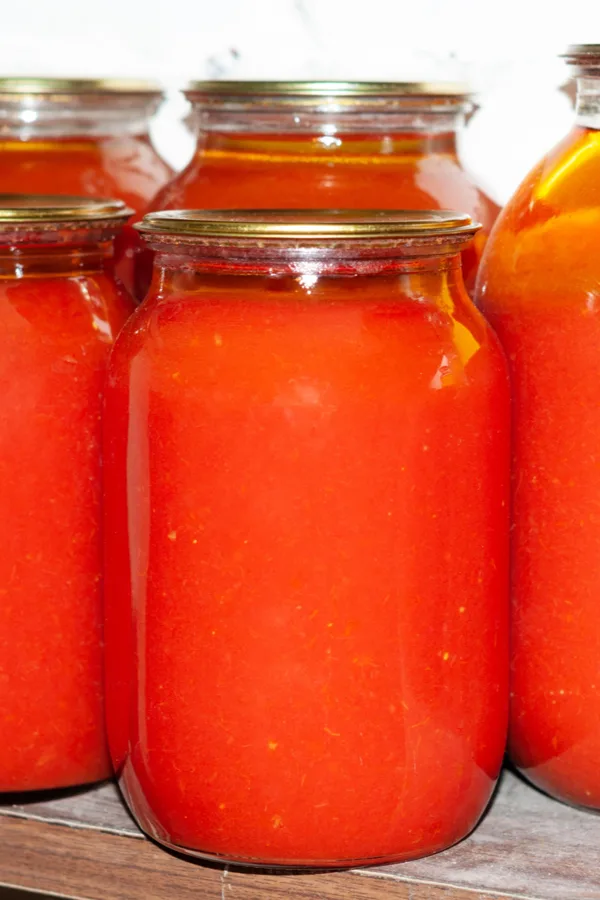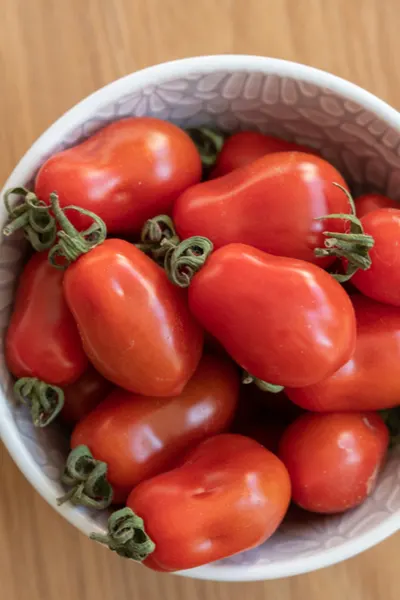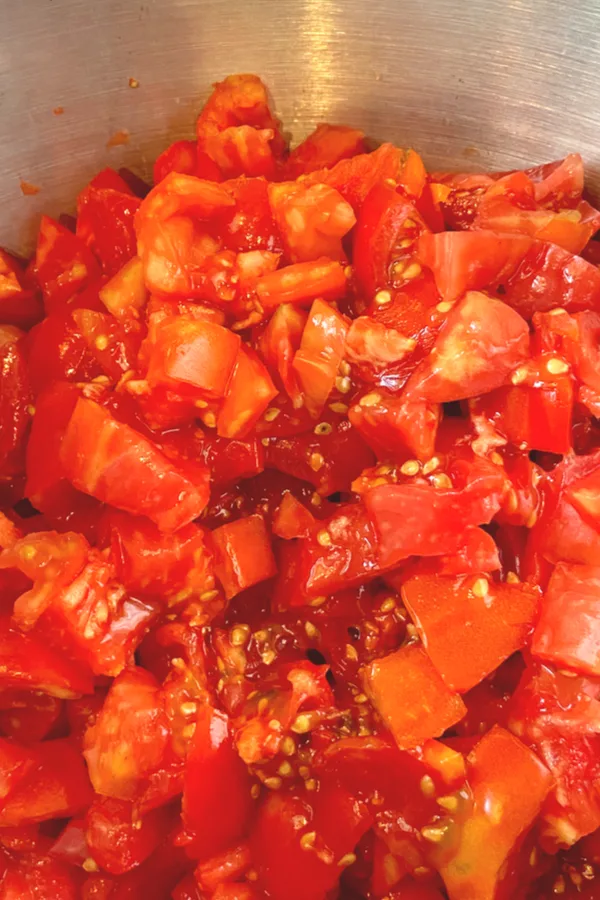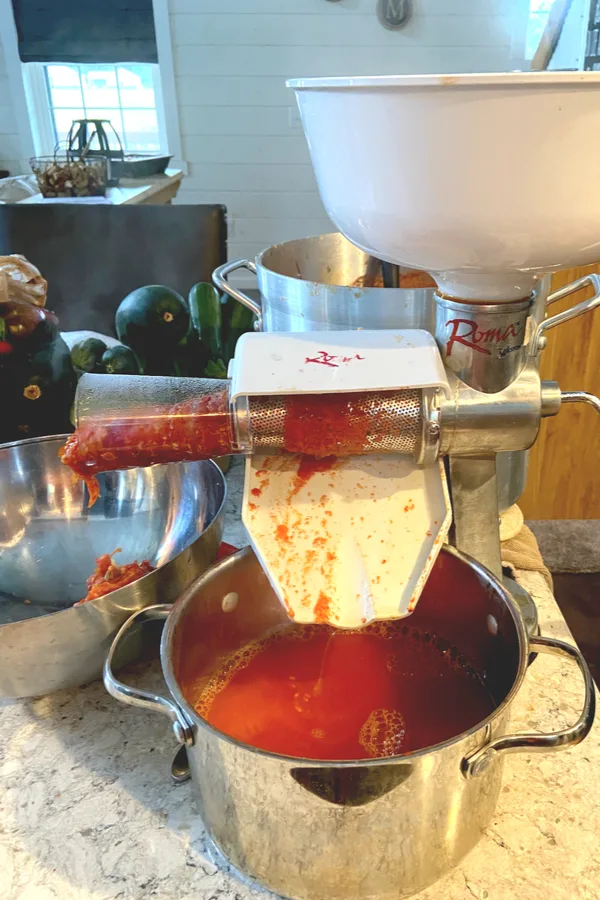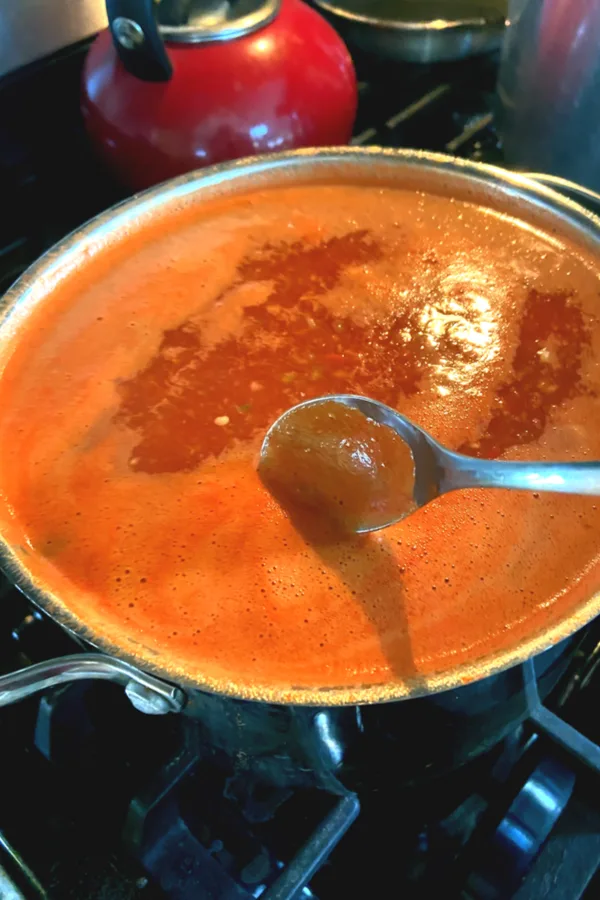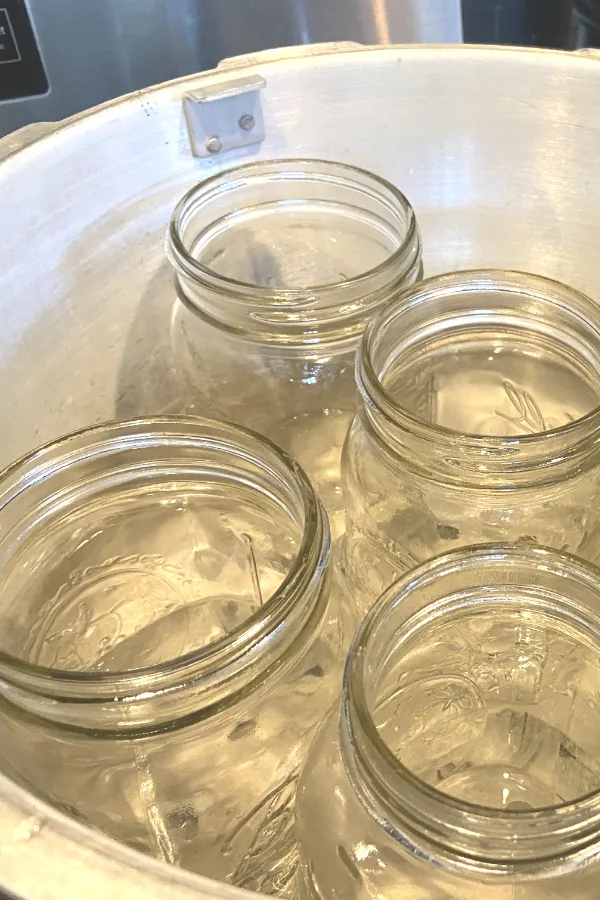Every year as the tomatoes begin to ripen in the garden, I know that it is time to get prepared to make and can tomato juice.
However, the first few ripe tomatoes from the garden are always used for eating raw. The excitement and anticipation of watching our seeds grow into tomato plants that produce delicious fruit in our own garden is finally fulfilled.
And to be honest, those initial tomatoes that are picked don’t even make it to the house. We eat them right off the stem!
However, one week later and it seems that every tomato plant is producing an abundance of ripe tomatoes!
Each day we pick what we think is every ripe tomato, only to stroll through the garden one last time and see at least a half a dozen or more hidden between the foliage.
And before they become over ripe we know that we must make and can tomato juice.
This is one of the very first things that we learned to can many, many years ago. It’s so easy, and with a little help of some valuable canning equipment products, it takes very little effort.
How To Make and Can Tomato Juice
What Tomatoes To Use:
You can use any tomato to make juice, however, some are better to use than others. Typically, the larger the tomato the more juice content that it holds.
We prefer to use a variety of tomatoes in our juice. Heirloom tomatoes such as Brandywine and Purple Cherokee sometimes aren’t the prettiest fruit, but they are extremely flavorful and make fantastic juice!
And when you can’t think of anything else to do with the buckets of cherry tomatoes that you have picked, throw them in the pot as well!
Because paste tomatoes such as Roma, San Marzano, and Amish Paste have thick, meaty walls we do not typically add them in for juicing. However, they are the star of the show in our salsa, pasta sauce and diced tomatoes recipes.
Although you can use just about any variety of tomato, there is one word of caution when you make and can tomato juice. Be sure to stay away from using primarily low acid tomato varieties.
The natural acid in tomatoes is what makes it safe to can without adding in a ton of preservatives. However, If you prefer to use mostly low acid varieties, I would recommend freezing the juice rather than canning.
The Process:
As a general rule — an 8 quart pot of small, chunked tomatoes will yield approximately 6-7 quarts of tomato juice.
1. Wash the tomatoes.
2. Remove core and any bad spots.
3. Cut your tomatoes into small chunks. The smaller the chunks, the faster the process.
4. In a large non-reactive stockpot over medium heat place enough chunks of tomatoes to fill the pot 1/6th full. As they begin to heat up, mash the tomatoes with a potato masher to release the juices. Stir frequently to prevent the bottom of the pot from burning. Bring the broken down tomatoes to a light boil.
5. As soon as the pot begins to boil, immediately add the remaining tomatoes. Stir frequently to prevent burning. As the tomatoes begin to heat up, you will have more room in your pot if you want to add more tomatoes.
6. Bring the pot back up to a boil and simmer for approximately 5-10 minutes or until tomatoes can be smashed easily.
Use a Food Mill or Strainer
7. Then pour the tomatoes through a food mill to remove the seeds and skins. We use a Roma Food Strainer and Sauce Maker. The time it saves us from not having to peel and de-seed the tomatoes is well worth the purchase! Plus we use it to make salsa and applesauce as well!
8. Place the strained juice back in the stockpot over medium-high heat. Then bring it back to a boil for 10 minutes.
9. In sterilized canning jars add 1 tablespoon of bottled lemon juice to each pint, or 2 tablespoons in quart jars. Fill jars with hot tomato juice, leaving 1/2 inch headspace.
Then use a clean cloth to wipe the rim clean. Then add the lid on top and apply the band just until finger-tight.
*Most lids now have the Sure-Tight technology which discourages heating the lid prior to placing it on top of the mason jar. Be sure to check what variety that you have purchased.
Process time:
Processing times for canning are all based on 1,000 feet and below sea level altitude. You will need to adjust processing time based on your specific altitude. See altitude adjustment guidelines.
Hot Water Bath – 35 minutes pint jars & 40 minutes quart jars
Pressure Canner – 10 lbs of pressure for 15 minutes for both pint & quart jars
We prefer to pressure can our tomato juice in our Presto Pressure Canner. We feel like the process is much easier and there are no worries about too much water evaporating during the lengthy water bath processing time.
**In order to prevent water spots from appearing on pressure canned jars, place 2 tablespoons of distilled white vinegar directly in the water of the pressure canner.
Please note: It is not safe or recommended to can tomato juice using the Open Kettle canning process. This is where you heat the tomato juice to boiling, put it in sterilized jars and apply the lid and ring. The heat of the food will cause the lid to seal shut.
Although your Grandmother, mother, or even yourself might have once ‘canned’ this way, this is not an approved method for canning. It is best to use either the water bath or pressure canning method instead.
How to Store:
Once the processing time is complete. Allow the jars to sit in the hot water with the burner turned off for 5 minutes. Then carefully remove the jars from the canner, place them on a thick towel and allow them to cool for 24 hours.
At that time, test each individual lid to see if it has sealed properly. You can easily do this by pressing on the center of the lid.
If there is any movement, the jar did not seal properly. Just put any jars that didn’t seal into the refrigerator. It is still safe to consume as a refrigerated product.
Store the properly sealed jars in a cool dark place. Be sure to label each jar and the date when it was processed.
You may notice separation of liquid in the jar. This is perfectly normal in homemade canned tomato juice. The separation occurs during the long process that it takes to bring the tomatoes to a boil.
Adding in the little bit of tomatoes and bringing those to a boil before filling the pot will help reduce the amount of separation.
Regardless of the looks, a properly sealed jar of tomato juice and lemon juice is safe to consume.
How to Use Tomato Juice:
Use your homemade tomato juice in any recipe. It is terrific to use as the base for Homemade Vegetable Soup, over meats, in stews, and of course tomato soup.
You can also use it as the base of spaghetti sauce. Just combine it with a little tomato sauce, tomato puree and Italian spices.
And of course, don’t forget just drinking it as a healthy alternative to store-bought juices. Add in a little heat and you have made your own V-8 juice!
To view all of our Canning Recipes click: HERE
Enjoy!
Mary and Jim
To receive our3 Home, Garden, Recipe and Simple Lifearticles each week, sign up below for our free email list. You can also follow us on Facebook, Twitter, Pinterest, or Instagram. This article may contain affiliate links.
Check Out This Week’s New Garden Podcast:
How To Make Your Own Tomato Juice
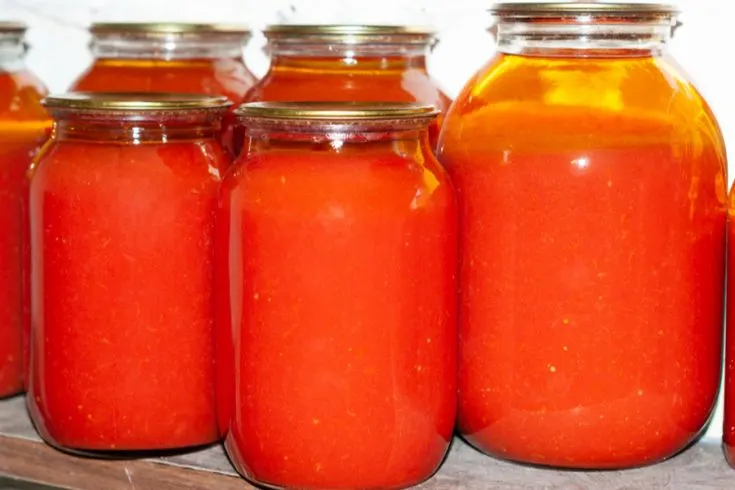
Ingredients
- Tomatoes
Instructions
- Wash and clean your tomatoes, be sure to remove any bad spots and discard any tomatoes that are overly ripe or show signs of decay or rot.
- Dice up tomatoes into smaller 1/2" to 3/4" chunks - enough to fill a 6 or 8 quart stock pot
- Place stock pot on medium low heat and let the tomatoes start to cook down slowly - making sure to stir every 5 minutes or so to prevent burning on the bottom of the pan.
- As the tomatoes cook down - we like to add a few more fresh-cut tomatoes to keep the stock pot full.
- Continue to cook down tomatoes until they become soft and fall apart at the touch
- At this point - we run our tomatoes through our food mill to remove the skins and seeds and squeeze out the juice. We use the tomato press because of the quantity - but for small batches - the food mill will work great.
- Once all the tomatoes have been run through - return the liquid into a stock pot and begin to heat through on medium to medium high heat. You want to get the tomato juice to a slow rolling boil.
- Let boil for 10 minutes and you are ready to can.
- Sterilize your pint or quart jars by running through your dishwasher - and then heat the jars in a separate stock pot.
- Add your juice to quart jars that are heated, along with 2 tablespoons of lemon juice, leaving 1/2 inch headspace. The lemon juice will not change the flavor - it is only included to help increase the acid level. Optional - add a half teaspoon of salt per quart jar for taste.
- Wipe the rim, and seal with the lid and band. Process quarts in a hot water bath for 40 minutes or in a pressure canner with 10 lbs. of pressure for 15 minutes.
- Remove jars and place on a towel and let cool for 24 hours before storing, Check to make sure all jars are sealed by pushing on the lid - if the lid is down and won't move it is sealed appropriately. If not - immediately place in your refrigerator and use within 2 weeks.
Notes
Recipe courtesy of Old World Garden Farms
Nutrition Information:
Serving Size:
1 gramsAmount Per Serving: Unsaturated Fat: 0g

